
Most guides on growing your Twitter account are useless.
They tell you to “post consistently” or “engage with others.”
Generic tips. No context. No systems. No results.
The real problem?
You’re not struggling because you don’t have enough time or talent.
You’re struggling because you’re following scattered advice—leftovers from older social media platforms—that was never built for new 𝕏 accounts in 2025.
The algorithm has changed.
Attention spans have shrunk.
And the platform rewards clarity, identity, and connection, not random posting.
If you’re serious about hitting 1,000 followers, you need more than good tweets.
You need a full system that will tell you:
- What to post
- When to engage
- Who to engage with
- And how to position yourself so people hit “Follow” button without thinking twice
This guide breaks it all down.
Step-by-step.
No fluff.
Just the exact playbook we’ve used to help creators go from 0 to 1K—and beyond.
Let’s start.
Why 1,000 Followers Changes Everything (And What Actually Unlocks)
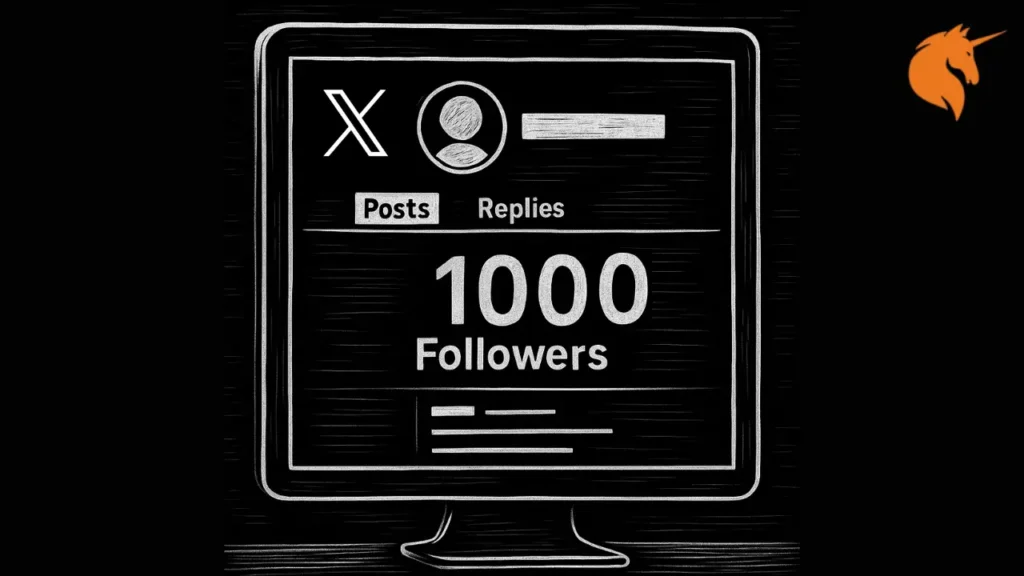
You might be thinking:
“Why bother chasing 1,000 followers? Isn’t that just a vanity metric?”
Fair question.
Here’s the truth:
1,000 followers changes everything.
Not because the number itself matters, but because it’s the tipping point where the platform starts working for you.
Here’s what hitting 1K actually unlocks:
- Social proof: People take you more seriously. Cold DMs convert better. Even big accounts are more likely to reply or follow back.
- Feed reach: The algorithm starts surfacing your content to second-degree networks more reliably.
- Inbound attention: You’ll start seeing people follow you without engaging first. That doesn’t happen at 238 followers.
- Conversion power: You’re no longer seen as “new.” You’re seen as established. That matters when you promote products, land collabs, or pitch yourself.
More importantly?
If you can grow to 1K with a system, you can scale to 10K.
Because the skills don’t change.
Just the surface area.
This isn’t about chasing numbers.
It’s about building leverage.
Ready to get there?
Let’s break it down.
The Psychology Behind Why People Follow You
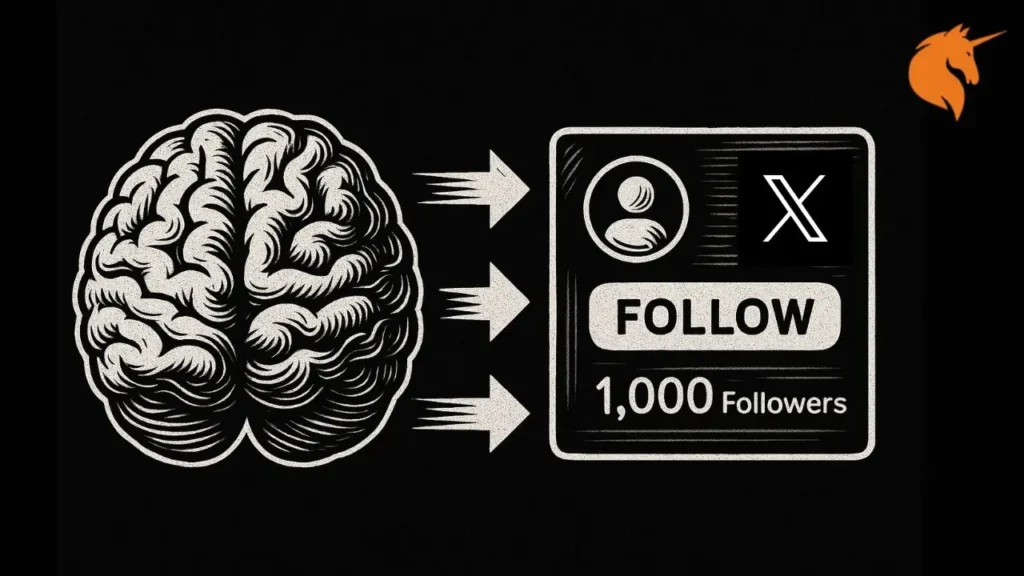
Most people think growth comes from being consistent, entertaining, or “providing value.”
But that’s only half the story.
People follow you because your content helps them get something done.
Whether that’s learning a tactic, solving a problem, staying informed, or simply getting entertained, it serves a purpose.
Your content is doing a job.
And the better it does that job, the faster you grow.
That’s why, before writing a single post, you need to understand what your audience is actually looking for—and position your content to deliver exactly that.
This idea is at the core of how we build content systems that work.
All you need to know for now:
People don’t follow creators—they “hire” solutions.
Your job is to figure out what outcome your audience wants and become the account that delivers it.
Below, we’ll walk you through that process step by step, starting with the foundation of it all: picking a niche.
If you want our complete system for building a growth engine on X, that’s inside The X Growth Playbook.
But for now, let’s get into it.
Step 1: Pick a Niche (and Stick to It)

Most creators try to grow by talking about everything.
They post about mindset, marketing, business, and personal stories—hoping something lands.
But here’s the truth:
If your account is about everything, it stands for nothing.
Niching down is how you make people care.
It’s how your profile becomes followable, your content becomes memorable, and your growth compounds over time.
When people visit your profile, they’re asking one thing:
“Is this relevant to me?”
If the answer isn’t clear in 3 seconds, you’ve already lost the follow.
A strong niche gives people a reason to stick around. It tells them:
- What to expect
- Why it matters
- Why you’re the person to follow
You don’t need to obsess over sub-niches or micro-positioning. But you do need a clear angle.
Here’s a simple way to pressure-test it:
Pick a topic that sits at the intersection of:
- What you enjoy talking about
- What you have experience or insight in
- What people actually care about or struggle with
If your niche checks all three, you’re good to go.
Takeaway:
Generalists scroll. Specialists grow.
Pick a lane, stick to it, and let that clarity fuel everything you do next.
Up next: how to make your profile convert traffic into followers.
Step 2: Make Your Twitter Profile Follow-Worthy
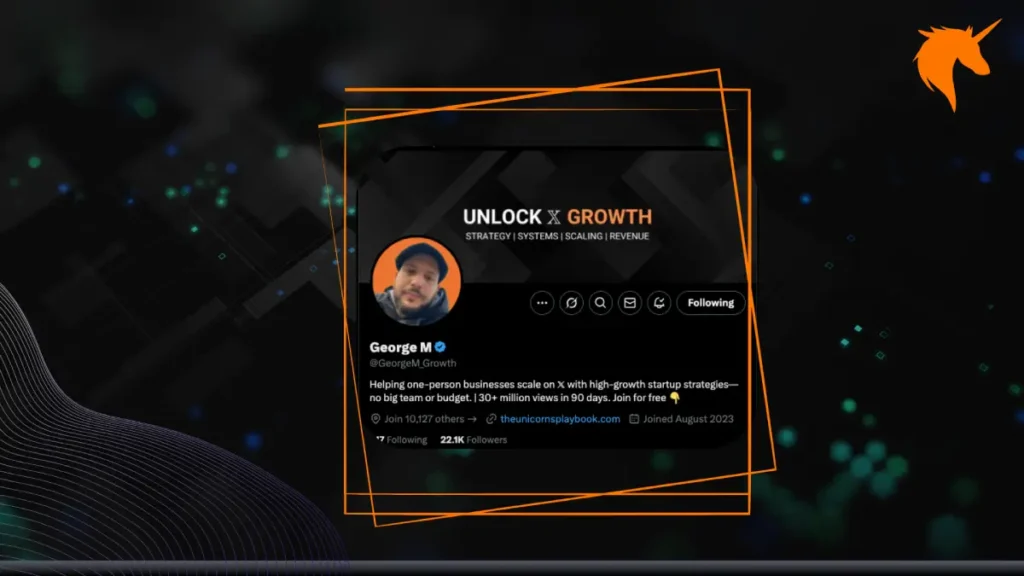
Once someone sees your reply or post, they do one thing before hitting follow:
They check your 𝕏 profile.
This is your conversion page.
If your Twitter profile doesn’t instantly tell them who you are, what you talk about, and why they should care—they’re gone.
Here’s how to fix it:
1. Your Bio
This is your positioning statement. Make it sharp.
Good bio formula:
I help [who] achieve [result] through [method].
Keep it clear, specific, and value-driven. No filler, no jargon.
❌ “Builder. Dreamer. Growth hacker.”
✅ “Helping solo founders grow to $10K MRR with 3 posts/day.”
2. Profile Photo & Banner
Your profile picture should be high-contrast and recognizable. Avoid logos unless you’re an established brand.
Your banner is underused real estate. Use it to show your offer, tagline, or proof (like “20K+ founders helped” or “Free toolkit below”).
3. Your Pinned Post
This is your proof. Pin your best-performing tweet, a strong intro thread, or a mini-case study.
Make it do one of three things:
- Prove expertise
- Showcase value
- Tell a story that builds trust
Bottom line:
If your profile can’t sell your account in 3 seconds, it’s costing you followers every day.
Next, we’ll talk about who to engage with—and how to actually get seen.
Step 3: Prioritize Engagement (It’s the #1 Growth Driver Under 1K)
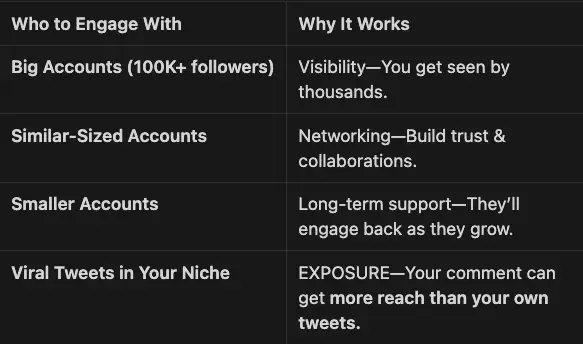
I couldn’t emphasize this enough:
If you’re under 1,000 Twitter followers, engagement is more important than your own content.
No matter how good your tweets are, almost no one will see them—because the algorithm doesn’t promote small accounts.
But when you leave a smart, relevant reply under a bigger creator’s post?
You instantly show up in front of the right audience.
That’s why replies are your highest-leverage growth tool early on. They:
- Get you seen—without needing followers or reach
- Trigger profile visits (and follows) from curious readers
- Build relationships and trust faster than tweets alone
Because replying and engaging is a complete growth strategy on its own, we’ve created a dedicated guide that walks you through everything—from who to reply to, how to structure your comments, and how to build daily momentum:
👉 How to Reply on Twitter the Right Way – Full System
Key takeaway:
Stop waiting for the algorithm to bless your content.
Earn attention by showing up where your audience already is—because visibility and engagement levels rise when you start the conversation instead of waiting for one.
Next up: what kind of content to post to turn attention into 𝕏 followers.
Step 4: Create Growth-Focused Content (What Actually Attracts Followers)
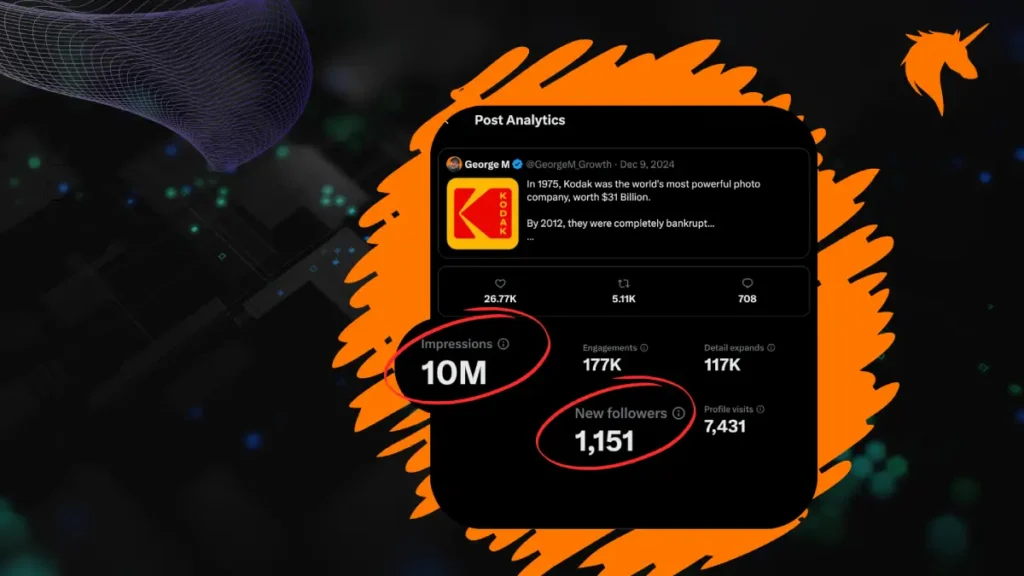
You’ve optimized your profile, picked a niche, and started engaging.
Now it’s time to make sure your content strategy pulls people in.
Because here’s the truth:
Not all content grows your audience. Some formats are just better at attracting new followers.
We call these Growth Posts—and they’re especially important when you’re in the early stages (0–1K followers).
These formats are designed to:
- Expand your reach
- Show off your expertise
- And get the right people to follow you
Here are 5 exclusive content formats that consistently work when your goal is to gain followers:
1. Viral Threads
Multi-part posts that go deep on one topic.
They increase time-on-post (a major algorithm signal) and showcase your thinking.
How to use them well:
- Start with a bold hook: “I tested 100 cold emails. Here’s what actually worked.”
- Use line breaks, bullet points, and clarity to keep people reading.
- End with a CTA that invites a follow or reply.
2. Giveaways
They create viral loops when done right—but only if they attract relevant followers.
Best practices:
- Offer something niche-specific (a checklist, template, or PDF).
- Require a follow and engagement (like, comment, or DM) to access it.
- Keep the copy short, punchy, and benefit-driven.
3. Newsjacking Threads
These let you comment on trending topics—but through your niche lens.
Why they work:
They tap into existing momentum while positioning you as someone worth following.
Example:
“The Google AI leak revealed 5 key lessons for solopreneurs. Let’s break them down 🧵”
4. Viral Lists
People love lists—they’re quick to consume and feel instantly valuable.
To make them work:
- Be specific: “5 underrated SEO tactics for early-stage SaaS”
- Make every item count—snackable, practical, and clear
- Use curiosity-driven titles: “The 3 tools I use every day to save 5+ hours”
5. Comparison Posts (X vs. Y)
These perform well because people are already thinking about tradeoffs.
Use this structure:
“Cold Email vs. LinkedIn Outreach—Which works better in 2025? Pros, Cons, and When to Use Each 🧵”
These formats help you reach new eyeballs and turn profile views into actual follows.
We cover each of these in-depth inside our course with:
- Hook templates
- Viral structure formulas
- And real-world examples from accounts that scaled fast
But for now, all you need to know is this:
👉 Not every post grows your audience—so focus on formats built for follower acquisition.
Start with threads, news takes, and short listicles—and stay consistent.
In the next section, we’ll talk about how to retain and convert those new followers.
Step 6 – Avoid the Mistakes That Kill Growth

You’re showing up daily. You’ve started building momentum.
This is the stage where most people shoot themselves in the foot.
Not because their content is bad—but because they follow advice that no longer works, or they burn out chasing short-term gains.
Here are the most common mistakes that kill growth on X—and how to avoid them:
❌ Mistake #1: Playing the Follow-for-Follow Game
This strategy is straight out of 2016—and it doesn’t work anymore.
Randomly following people just to get followed back might inflate your numbers, but it destroys your follow ratio, clutters your feed, and builds zero real connection.
Why it fails:
→ You attract the wrong audience (or bots).
→ You look spammy to the algorithm.
→ Your engagement rate tanks.
Do this instead:
Follow accounts that inspire, educate, or interact with you. Focus on building signal, not vanity numbers.
❌ Mistake #2: Buying Followers or Engagement
If you’re buying followers, likes, or retweets—you’re not building a brand.
You’re inflating a balloon with holes in it.
Why it fails:
→ Fake followers don’t engage.
→ Your content reaches no one.
→ Your authority drops to zero the moment people check your replies.
Reminder: 10 real fans > 10,000 ghost accounts.
❌ Mistake #3: Posting Without a System
You’ve seen it:
→ A burst of 3 threads in one day.
→ Then nothing for a week.
→ Then random late-night tweets with zero structure.
Why it fails:
→ The algorithm rewards consistency.
→ Your audience forgets you if you disappear.
→ You burn out trying to guess what works.
Fix: Use the simple daily + weekly system we covered earlier.
Write when your mind is fresh. Schedule to stay consistent.
❌ Mistake #4: Posting Like You Already Have 100K Followers
You see it all the time:
→ Single-tweet platitudes.
→ One-liner “wisdom.”
→ Vague inspirational quotes.
This works if you already have 100K+ followers. But when you’re small?
Why it fails:
→ No one sees it.
→ There’s no context, no story, and no value.
→ The algorithm doesn’t push it, and even if it does—no one follows from it.
Fix:
Use growth-focused formats that give people a reason to follow—threads, carousels, value-packed tweets.
Your content needs context and substance to convert viewers into followers.
When you’re small, don’t post like a big account—post to become one.
How Long Does It Take to Get 1,000 Followers?
This is one of the most common questions, and most blog posts either dodge it or throw out random numbers.
Here’s the truth:
It depends.
But if you follow a proven system, it’s not only doable—it’s fast.
Most beginners waste months posting random content, chasing likes, or doing outdated tactics like follow-for-follow. That’s why they stay stuck.
But when you:
- Optimize your profile
- Pick a clear niche
- Post growth content consistently
- And engage the right way
…you can hit 1,000 followers in 30 to 60 days—sometimes faster.
We’ve seen accounts get there in 21 days by doing nothing but high-volume replies and posting one strong thread per week.
What matters isn’t how long it takes—it’s whether you’re using a system or just winging it.
If you’re consistent, focused, and follow what we covered in this guide, 1,000 is just your warm-up.
You don’t need virality.
You need direction.
Final Checklist & 30-Day Action Plan
You don’t need hacks.
You need structure.
This is your no-guesswork, zero-fluff plan to hit 1,000 followers, fast. Follow it daily. Track your results. Adjust weekly. The growth will follow.
Final Growth Checklist
Before you start:
- Pick a clear niche with demand and staying power
- Optimize your profile (bio, banner, profile picture, pinned tweet)
- Define your Content JTBD (the job your content helps people with)
- Build engagement lists (creators across follower tiers)
- Set up your reply system (daily slots, high-quality comments)
- Choose your content formats (threads, viral lists, comparisons, giveaways)
Your 30-Day Action Plan
Daily (30–60 minutes)
- Engage with 10–15 relevant posts from your reply lists
- Post 1–2 growth tweets (use formats designed to attract followers)
- Track what gets replies, likes, and profile clicks
Weekly (1–2 hours)
- Write and publish one strong growth thread
- Review top-performing tweets from your own account and competitors
- Schedule the next week’s content using your content planner
- Update your reply lists (remove inactive or low-engagement accounts)
Monthly (Week 4)
- Analyze which tweets brought the most followers
- Identify patterns across content format, hook type, and topics
- Refine your JTBD based on audience behavior
- Improve your system for speed, output, or quality
Final Reminder
1,000 followers isn’t a vanity milestone. It’s your proof of concept.
If you follow a system, growth becomes repeatable. This 30-day sprint is designed to give you momentum. Your job is to stay consistent.
For the full system—including swipe files, templates, and our Notion growth workspace—check out The X Growth Playbook.
FAQ – Getting 1,000 Followers on Twitter
How long does it really take to get 1,000 followers?
With a focused system, most accounts can hit 1,000 followers in 30–60 days. The key is consistency, not luck.
Do I need to post every single day?
Yes—at this stage, daily posting (even multiple times per day) helps train the algorithm and keeps you top of mind. You don’t need to post a thread every day, but you do need to show up.
Is follow-for-follow still a thing?
No. It inflates your numbers but kills engagement and credibility. Focus on attracting real followers who care about your niche.
Should I buy followers to speed things up?
Absolutely not. Fake followers hurt your reach and damage trust. Twitter knows—and so do your real audience.
What kind of content works best for early-stage growth?
Growth-focused content: threads with strong hooks, viral-style lists, newsjacking posts, and curated giveaways. These expand your reach and earn follows.
What if I’m not a good writer?
Start simple. You don’t need to be a copywriter—you need clarity and structure. Use proven formats, study what works, and improve over time.
Can I grow without engaging with others?
It’s possible, but 10x slower. Engagement is the #1 growth lever in the early stages. Smart replies outperform random tweets every time.
How do I know what’s working?
Track followers gained per tweet/thread. Look for patterns in your top performers—hook style, format, topic. Then double down.
What happens after I hit 1,000 followers?
That’s where things really start. At 1,000+, you can shift from visibility to trust-building—threads, content depth, collaborations, and eventually monetization. You already have a growth system, so study your Twitter Analytics and double down on what works.

George Mastorakis is a digital marketer with 12+ years of experience in building and growing online businesses. From affiliate SEO sites and CPA funnels to agency work and leading growth at Synthesys from $0 to $1M ARR, he’s done it all. Today, he helps solo founders build a personal brand and scale their businesses using startup growth tactics he’s refined through years of hands-on experience.


Leave a Reply